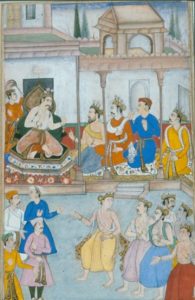Charles Ambrose Storey and the Razmnama Manuscript
This Saturday (21st August) marks the 133rd anniversary of the birth of the British Orientalist and former Fellow of the Society, Charles Ambrose Storey (1888-1968).

Storey studied Classics and Oriental languages at Trinity College, Cambridge where he specialised in studying Arabic. His interest in the language would influence his future career in academia and in 1914 he was appointed Professor of Arabic at the Anglo-Mohamedan Oriental College (now the Muslim University) of Aligarh, India. After working for a short period as a Librarian in the India Office, he was elected Sir Thomas Adams Professor of Arabic at Cambridge in 1933 – a position he held until his retirement in 1947.
Storey dedicated the rest of his life towards documenting sources for the study of Persian literature. One of his greatest achievements was the publication of ‘Persian Literature: A bio-biographical Survey’ (1927). This was envisioned by Storey as a counterpart to Carl Brocklemann’s ‘Geschichte der arabischen Litteratur,’ with Storey classifying the literature by topic rather than time period. Volume 1 (parts 1-3) and volume 2 (part 1) were published during Storey’s lifetime whilst volume 2 (parts 2-3) and volume 3 (parts 1-2) were published posthumously using the Society’s own funds. Unpublished manuscripts for volume 3 (part 3) and volume 4 are held by the Society and have recently been published by Brill: https://brill.com/view/title/59220. A continuation of this work, but on a different basis, began to be published by François de Blois in 1992. This formed volume 5 of the Bio-Bibliographical Survey series and is entitled ‘Poetry of the Pre-Mongol Period’.
Razmnama Manuscript:
When Charles Storey died in 1968, he bequeathed the whole of his estate to the Society, including his Library and art collection. This included two miniatures from a dispersed manuscript of the Razmnama, a Persian translation of the Hindu epic Mahabharata, described as the longest poem ever written. The translation was commissioned by the Mughal Emperor Akbar, as part of a major programme of translating Sanskrit texts into Persian. This was itself part of a long-term project to make Persian the official language of the Mughal Empire and political elites. Another 24 miniatures from the manuscript, which was copied in AH 1007 (1598/99), are at the British Library (BL Or. 12076).

Miniatures in the RAS Collections:

The first miniature that is held within the Society’s collections is of Bhagvan Bharata shooting at Hanuman. Bharata is a Hindu deity and was born to the virtuous king of Ayodhya, Dasharatha and his second wife, Queen Kaikeyi. Hanuman is a Hindu God and divine vanara companion of the god Rama.

The second miniature was inscribed in Persian as ‘The audience of the Pandava brothers together with Krishna before Duryodhana before battle’. The Pandava brothers were: Yudhishthira, Bhima, Arjuna, Nakula and Sahadeva. The Pandavas waged a civil war against their extended family consisting of their cousins the Kauravas led by Duryodhana and his brothers, as well as their preceptor and gurus Bhishma and Drona respectively. This conflict was known as the Kurukshetra War. The Pandavas eventually won the war with the demise of the Kauravas, albeit at a great cost .
